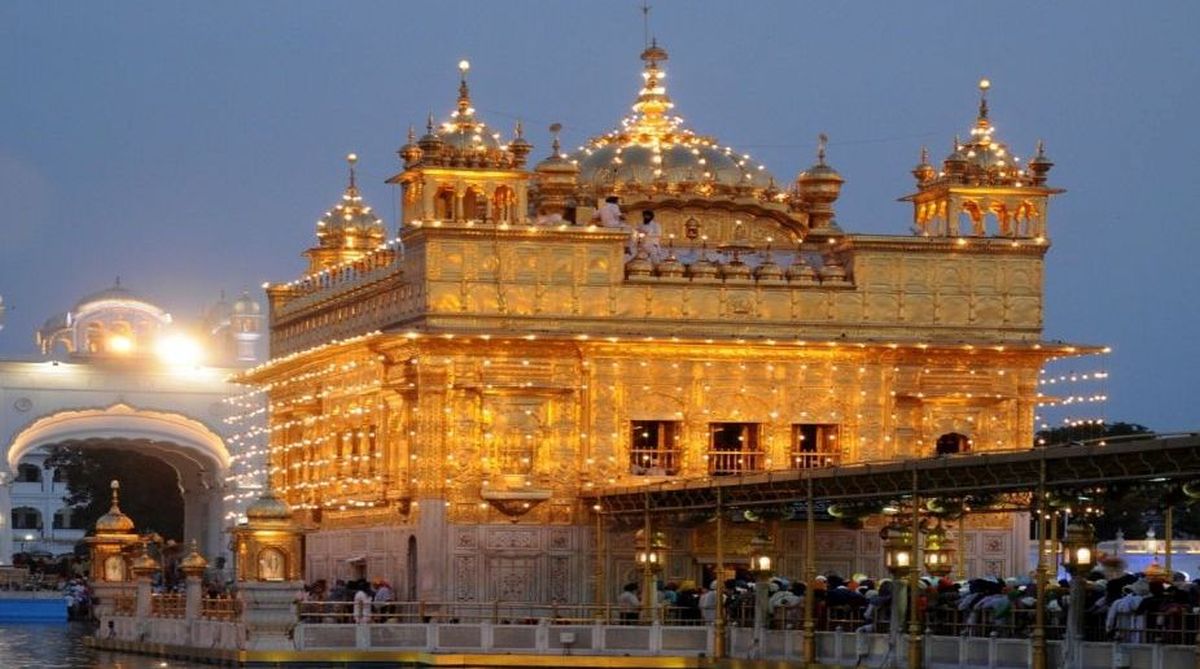Teachings of Guru Granth Sahib will always guide us towards a better society: Amit Shah on Prakash Parv
"Best wishes to everyone on the occasion of Prakash Parv of Sri Guru Granth Sahib Ji," Shah posted on 'X', formerly Twitter.
Sikhism affords the highest respect to the Gurus and its holy scripture, the Guru Granth Sahib.

Golden Temple (Photo: IANS)
There are about 20 million Sikhs in the world. The 2001 census recorded 3, 36,000 Sikhs living in the UK alone. They are residents in almost every country and form 0.39 per cent of the world’s population. Sikhism is the world’s fifth largest religion, which was started by Guru Nanak (1469 to 1539).
All Sikh Gurus, since Guru Nanak, have worn turbans, but wearing turbans, by Sikhs, was made official by Guru Gobind Singh, the tenth Guru. Their famous leader, Maharaja Ranjit Singh, (1780-1839), who led the Sikh Empire in the early 19th century, which covered North-west India, greatly influenced his people with the teachings of Guru Nanak, to form one kingdom with people who respected their community.
Guru Nanak explained that “Even if hundreds of moons were to shine or there were thousands of suns showing, the sunshine there would still be no effect on the darkness of ignorance in our hearts, because despite the brightness, without the Guru’s guidance, total darkness will appear all over.”
Advertisement
To reinforce these thoughts, he borrowed Kabir’s words, “What could you do when a person carrying a lamp in the hand still falls in the well?” Part of the concluding words in the hymn, Mundavani, consistently carries the precept of the importance of the Divine Word — “The word of the True Lord is the mainstay of the whole world.”
Hymns in the Guru Granth Sahib are termed as Gurbaani. Guru in Sikhism is a spiritual enlightener. The prefix, Guru, is used for the ten Sikh Gurus, from Guru Nanak to Guru Gobind Singh. After the demise of the last Guru in 1708, the status of “Guru” was passed on for all time to the Guru Granth Sahib. Granth denotes the scripture of the Sikhs.
The term Sahib refers to an honorific title, signifying the Lord. No matter how revered a Sikh personality may be, the title Guru cannot be used. Therefore in Sikhism, the Guru Granth Sahib continues to command the same honour as would have been due to the then living Gurus themselves from 1469 to 1708.
There were times when Guru Nanak during his discourses to a congregation would pour his vision in the form of hymns, which were devotional, deeply reflective and morally inspiring. He recorded and compiled these verses, or Baani, into a sacred volume.
With a view to share and perpetuate his spiritual message, Guru Nanak travelled widely on foot, accompanied by one of his most devout followers, Bhai Mardana, a Muslim, who played the rebec while Guru Nanak sang.
The rebec, a bowed stringed instrument of early Renaissance times, was developed in the 11th century by an Arab. The prevalent culture of those centuries depicts India, through its different beliefs, evoking a fascinating dimension of the sub-continent’s diversity.
These religious leaders lived in unbelievable harmony with other religions, which if juxtaposed with present times, is viewed differently. Mardana, a Muslim, as a follower of Guru Nanak, is one of many examples. Akbar inviting the famous musician, Tansen, to discuss equality of different beliefs, is another, because Tansen was influenced by Swami Haridas.
Guru Nanak’s commitment was not only confined to the length and breadth of India; his indefatigable efforts included tours of Afghanistan, Arabia, Iraq, Iran, Burma, Sri Lanka and Tibet.
During these tours his agenda was remarkably simple — he exchanged his views with other religious leaders and convinced them with a precept, that there was “One Almighty God,” looking after us.
He explained that in God’s Court it was a person’s deeds that mattered, not the person’s religion or appearance. Most of his followers were poor missionaries who established Righteous Assembly Places or Dharamshalas, some which are maintained even in present times.
When Guru Nanak died in 1539, he was replaced by Guru Angad, who continued from 1539 to 1552.
During Guru Arjun’s Guruship, he had the Durbar Sahib or main congregation hall built. He compiled short collections of the Baani into one volume.
Compositions, including Guru Arjun’s own hymns, were arranged in a series of musical compositions or ragas, comprising 31 including the famous Jaijawanti Raga. Hymns were added by later Gurus.
The sacred scripture was completed in 1604, and thus the Guru Granth Sahib was ceremoniously installed in the inner sanctuary of the Darbaar Sahib, Amritsar. Subsequent to Guru Gobind Singh’s demise in 1708, this sacred text has been revered by Sikhs.
The traditional convention related to the Guru Granth Sahib is unequivocal, “No book shall be installed like the ‘Granth’.” The standard format in this Holy Scripture is in the Punjabi language, in the Gurmukhi script, and is printed on 1,430 pages.
One of the hymns articulate, “As a stone is kept immersed in water but the water penetrates it not, so we deem the person who is without worship and love of the Lord God Almighty.” Humanity is thus left to reflect who is like a stone or who is God fearing.
Advertisement